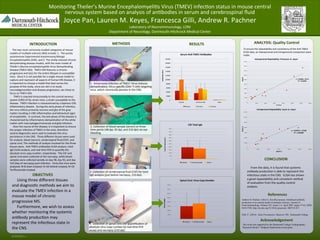More Related Content
Similar to 2014 Spring Poster (20)
2014 Spring Poster
- 1. RESEARCH POSTER PRESENTATION DESIGN © 2012
www.PosterPresentations.com
4.
Collec/on
of
spinal
cord
(for
quan/fica/on
of
absolute
virus
copy
number
by
real-‐/me
PCR
assay)
and
necropsy
(210
dpi).
INTRODUCTION
OBJECTIVES
METHODS
RESULTS
ANALYSIS:
Quality
Control
References
Acknowledgement
This work was supported by the Dartmouth College Undergraduate
Research David C. Hodgson Endowment award grant.
Laboratory
of
Neuroimmunology,
LONI
Department
of
Neurology,
Dartmouth-‐Hitchcock
Medical
Center
Joyce
Pan,
Lauren
M.
Keyes,
Francesca
Gilli,
Andrew
R.
Pachner
Monitoring
Theiler’s
Murine
Encephalomyeli/s
Virus
(TMEV)
infec/on
status
in
mouse
central
nervous
system
based
on
analysis
of
an/bodies
in
serum
and
cerebrospinal
fluid
2.
Collec/on
of
blood
sample
(serum)
at
three
/me
points
(48
dpi,
92
dpi,
and
210
dpi)
via
eye
bleeding.
1.
Intracranial
Infec/on
of
TMEV:
Virus-‐Induces
demyelina/on.
Virus-‐specific
CD4+
T-‐cells
targe/ng
virus,
which
chronically
persists
in
the
CNS.
3.
Collec/on
of
cerebrospinal
fluid
(CSF)
for
total
IgG
analysis
(just
before
necropsy,
210
dpi).
y
=
0.9603x
+
8172
R²
=
0.82285
0
20,000
40,000
60,000
80,000
100,000
120,000
140,000
160,000
180,000
0
20,000
40,000
60,000
80,000
100,000
120,000
140,000
Joyce
Francesca
Interpersonal
Repetability:
Francesca
vs.
Joyce
y
=
0.8107x
+
11346
R²
=
0.82989
0
20,000
40,000
60,000
80,000
100,000
120,000
140,000
0
20,000
40,000
60,000
80,000
100,000
120,000
Joyce
1
Joyce
2
Intrapersonal
Repetability:
Joyce
vs.
Joyce
0
5,000
10,000
15,000
20,000
25,000
30,000
35,000
40,000
45,000
50,000
Total
CSF
IgG
(ng/mL)
CSF
Total
IgG
Vehicle
Teriflunomide
Sham
0
20000
40000
60000
80000
100000
120000
140000
160000
180000
200000
Vehicle
Teriflunomide
Sham
An`bodies
`ters
48
Days
92
Days
210
Days
Serum
An`-‐TMEV
An`bodies
0
50,000
100,000
150,000
200,000
250,000
300,000
350,000
400,000
Virus
Copies
Spinal
Cord:
Virus
Copy
Number
Vehicle
Teriflunomide
Sham
Andrew R. Pachner, Libin Li, Kavitha narayan, Intrathecal antibody
production in an animal model of multiple sclerosis, Journal of
Neuroimmunology, Volume 185, Issues 1-2, April 2007, pages 57-63, ISSN
0165-5782, http://dx.doi.org/10.1016/j.jneuroim. 2007.01.017.
Gilli, F. (2014). Data Presentation. Hanover, NH. Dartmouth College.
CONCLUSION
The
two
most
commonly
studied
categories
of
mouse
models
of
mul/ple
sclerosis
(MS)
include:
1.
The
purely
autoimmune
Experimental
Autoimmune/Allergic
Encephalomyeli/s
(EAE),
and
2.
The
virally
induced
chronic
demyelina/ng
disease
models,
with
the
main
model
of
Theiler’s
Murine
encephalomyeli/s
Virus
Demyelina/ng
Disease
(TMEV-‐IDD).
TMEV-‐IDD
features
a
chronic-‐
progressive
and
lasts
for
the
en/re
lifespan
in
suscep/ble
mice.
Since
it
is
not
possible
for
a
single
mouse
model
to
capture
and
represent
all
aspects
of
human
MS
disease,
it
is
important
to
choose
a
model
that
best
serves
the
purpose
of
the
study,
since
our
aim
is
to
study
neurodegenera/on
and
disease
progression,
we
chose
to
focus
on
TMEV-‐IDD.
TMEV
is
injected
intracranially
to
the
central
nervous
system
(CNS)
of
SJL-‐strain
mice,
a
strain
suscep/ble
to
the
disease.
TMEV
infec/on
is
characterized
by
a
biphasic
CNS
inflammatory
disease.
During
the
early
phase
of
infec/on,
the
virus
infects
primarily
neurons
and
glia
of
the
gray
maher
resul/ng
in
CNS
inflamma/on
and
behavioral
signs
of
encephali/s.
In
contrast,
the
late
phase
of
the
disease
is
characterized
by
inflammatory
demyelina/on
of
the
white
maher
with
macrophages/monocyte
and
glial
infec/on.
Over
the
course
of
the
disease,
it
is
important
to
ensure
the
proper
infec/on
of
TMEV
in
the
mice,
therefore
several
diagnos/cs
were
used
to
evaluate
the
virus
persistence
in
the
CNS.
Three
different
/ssues
were
used
for
analysis:
blood
(serum),
cerebrospinal
fluid
(CSF),
and
spinal
cord.
The
methods
of
analysis
involved
for
the
three
/ssues
were,
An/-‐TMEV
an/bodies
ELISA
analysis,
total
IgG
ELISA
analysis,
and
real-‐/me
PCR
to
quan/fy
the
absolute
virus
copy
number,
respec/vely.
The
CSF
and
spinal
cord
were
collected
at
the
necropsy,
while
blood
samples
were
collected
serially
on
day
48,
day
92,
and
day
210
(day
of
necropsy)
post
infec/on.
Forty-‐five
mice
were
analyzed:
N=8
sham
treated;
N=18
Vehicle-‐treated,
N=19
Teriflunomide-‐treated.
Using
three
different
/ssues
and
diagnos/c
methods
we
aim
to
evaluate
the
TMEV
infec/on
in
a
mouse
model
of
chronic
progressive
MS.
Furthermore,
we
wish
to
assess
whether
monitoring
the
systemic
an/body
produc/on
may
represent
the
infec/ous
state
in
the
CNS.
From
the
data,
it
is
found
that
systemic
an/body
produc/on
is
able
to
represent
the
infec/ous
state
in
the
CNS.
ELISA
has
shown
a
good
repeatability
and
consistent
method
of
evalua/on
from
the
quality
control
analysis.
To
ensure
the
repeatability
and
consistency
of
the
An/-‐TMEV
ELISA
data,
an
interpersonal
and
intrapersonal
comparison
were
made.
